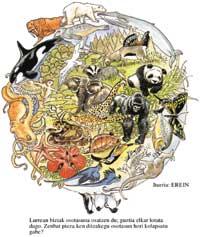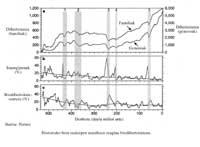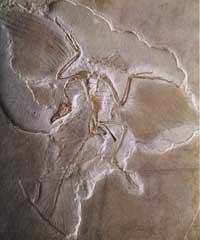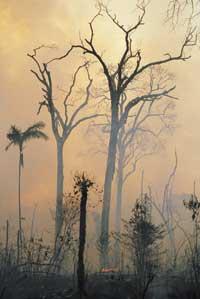Incidents of life
2000/04/02 Imaz Amiano, Eneko - Elhuyar Zientziaren Komunikazioa

Ecology is in part an experimental science, that is, part of knowledge is the result of experimental results. In this way, the presence of controlled distortions in a medium (elimination or reduction of some species, or changes in the ecosystem) allows ecologists to analyze the relationships between species and their relationships with the environment. However, to study the extinctions that occurred long ago and their subsequent biotic recovery (recovery of the number of living beings and species), paleontologists do not have this possibility, since it cannot alter the medium of several million years and see what happens. However, they can obtain explanations for observations using methods other than the study of such ancient fossils. In this way, we know that during that time there have been, at least, five large extinctions and a subsequent biodiversity recovery. Also the "crisis" and subsequent biotic recoveries of smaller size. The data of these extinctions and recoveries allow to establish comparisons between similar situations and search for general models. And how to calculate how long that recovery takes.
James Kirchner of the University of California and Anne Weil, of the University of Duke in North Carolina, have studied the marine fossils of the time mentioned and have seen that, regardless of the size of extinction (90%, 50% or 20% loss of species or biodiversity), to reach the maximum generation of biodiversity it takes ten million years.
Although research on recovery after expiration is very scarce in comparison with those of mass extinctions, we can cite lines that are valid for everyone. Thus, after the destruction, the biodiversity is very low and the generalist species of wide geographical extension predominate (like the one that today would be the fox), able to live anywhere and adapted to numerous ecological conditions. This period of low biodiversity would be a period of "survival". Below is a period of rapid appearance of new taxonomic groups that indicate that, despite the scarce data available, the speed has been different by region.

Until now, several theories that explained extinction and subsequent extinction saw species as islands. That is, if a species disappeared there was a free niche or ecological, and the only thing nature had to do to recover the balance was to fill it, either with some species already existing or creating some new species. From there, the harder the extinction, the more ecological niches would remain empty, so nature would take longer to create new species and to reach the new balance by filling all niches. However, it was considered that after extinctions there was an immediate, very rapid increase in biodiversity (model "a" of the chart). On average, after mass extinctions, the almost total recovery was considered to have occurred before five million years.
There was, however, a theory that said exactly the opposite. Long period of low diversity after large extinctions, followed by a progressive recovery (model "c" of the graph).

Now the research published in Natura addresses the problem from another point of view. The study of the marine fossils of the fanerozoic has begun (that is, for 570 million years to the present day), comparing the data obtained with those of expiry and recovery. It is not an easy task due to the sampling problems and the low extinctions that can be intercropped, but its results show that the maximum time of generation of the new genera (the classification level that groups the species) and the families (the classification level that groups the genera) is ten million years from the maximum of the extinction period, time that does not depend on the measure of extinction. In short, if the extinction is moderate, there are many ecological niches that have remained empty and, in addition, there are few species that serve as a basis for the creation of new alternative species and new species (in the destruction the factory has been left without raw material). That is why it will be more expensive to start filling those “holes”. However, once the number of basic species is reached during survival, all niches will be filled relatively quickly (model "b" of the chart). In addition, the new approach recognizes that species are interrelated, so the disappearance of a species affects others. If a few become extinct, the distortion produced in the environment is not so great, but if the destruction is quite accused it multiplies. Therefore, someone might think that protecting wolves is not very important, but the disappearance of wolves affects carnivores and herbivores that are their food. And the change in number and balance affects the forest; and if the forest is transformed it could collide with other species or produce less rain and then man should change the way of life or manage the territory; and if he goes further to seek water, he will transform the environment beyond...
Therefore, taking into account that the disappearance of the species that is causing the human being is also very fast and voluminous (remember that according to this model the measure of extinction does not affect), to "remedy it" nature will take ten million years to reach the conclusion of many
... Deformities and devastations.
Comparisons are never quite accurate, but here is an example. If in a forest we cleared a plot of one hectare and miss out, we would cause minimal destruction. In it the "survival" will be short, since there are species of landeros that will colonize the area. The first generalist plants will be included, which can survive in difficult conditions (in this case great sunshine, drought, raptor availability…). In this case we surely have not eliminated any species, but have reduced their quantity. However, if calvary is similar to the Iberian peninsula, there are colonizing species, but it will cost them to get very far. In addition, the plants that have managed to stay are scarce and will cost them to completely cover the gap and return to the previous situation. Recolonization will be slow. It will be necessary to obtain a minimum of plant species that cover the first calvary and then many others will arrive under their protection.

Now suppose we replace the bald with one or two species. This will also affect other species, but some other similar species will cover the left gap (always bearing in mind that the sensitivity to distortions of all means is not the same). If there are more missing species, the distortion (bald) will be more evident and it will cost nature more to fill that emptiness; 10 million years, right there. In fact, nature should create candidates who will form the first ecological balance (the first settlers of the clearing) and, subsequently, some of these candidates will develop species similar to those initially existing (species that will grow in the shelter of the colonizers or, in this case, will evolve from the colonizers).
Published in the supplement Natura de Gara

Gai honi buruzko eduki gehiago
Elhuyarrek garatutako teknologia






